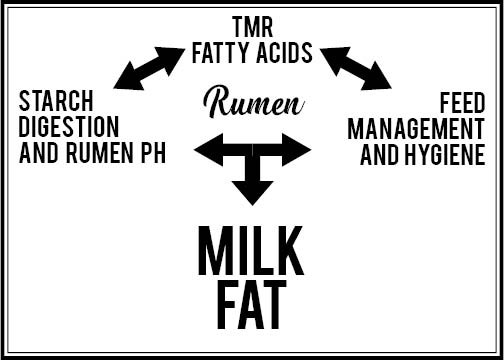
Over a portion of the Midwestern summer, milk components have declined (both milk protein and fat content) and butterfat value rose to a premium level, accounting for nearly 60 percent of the Class III milk price[1]. This seasonal milk fat decline, coupled with the fact that fat accounts for a majority of producers’ milk payments and marginal milk prices, has put fatty acid nutrition and fat tests in the focused crosshairs of nearly all dairy producers and their nutritionists.
“We [dairy cattle nutritionists and researchers] have come to understand that specific long-chain fatty acids can impact diet metabolism and energy partitioning, beyond just calories,” explains John Goeser, Rock River Laboratory Animal Nutrition, Research, and Innovation Director. “Concentration on this area is growing due to advancing research, nutrition technologies, and dairy economics.”
Similar to how nutritionists now formulate for specific amino acids (i.e. Lysine and Methionine), Goeser believes the dairy nutrition industry is transitioning towards better recognizing and feeding specific fatty acids.
Long-chain fatty acids
“The focal point of all this recent interest in fatty acids is long-chain fatty acids, meaning 16 to 22 carbons in length,” says Goeser. “The 16 and 18 carbon fatty acids are predominant in dairy diets.”[2] A few of these long-chain fatty acids are more familiar than many realize:
Palmitic (C16:0) fat has become much more prevalent in diets, with increased butterfat being recognized in part to the addition of this fat. This fat supplement may alter energy partitioning in the cow.
Stearic acid (C18:0) is the major fatty acid in tallow and likely leads to poor fat digestibility.[3]
Oleic acid (cis-9 C18:1) is a fat within supplements that likely improves total fat digestion by creating a more digestible fatty acid profile, which is better absorbed than some others.[4]
18-carbon fatty acids
The 18-carbon fatty acids with double bonds (Oleic, Linoleic, and Linolenic) can positively or negatively affect animal performance. “The C18:2 (two double bonds) and C18:3 (three double bonds) fatty acids are biohydrogenated into C18:0 (no double bonds) by rumen bacteria,” explains Goeser. “If all goes well, the C18:0 is used by the dairy cow. Yet when undergoing milk fat depression, we now understand that an inadequate rumen fat breakdown creates a negative intermediate fatty acid 9trans-10, cis-12 C18:2, Conjugated Linoleic Acid (CLA) that decimates milk fat content and dairy profitability.”
Comprehensive, routine Near Infrared (NIR) analysis tools are now available at commercial laboratories to investigate Total Mixed Ration (TMR) nutrition contributors to milk fat depression, such as TMR fatty acid content and profile, and extensive in situ rumen starch digestion measures. These TMR measures can help dairy nutritionists better quantify the Rumen Unsaturated Fatty Acid Load ((RUFAL), which consists of Oleic acid, linoleic acid, and linolenic acid contents.[5]

Goeser recommends dairy managers work with their nutritionist to review their TMR fatty acid profile in an effort to proactively manage or combat butterfat depressions challenges. He also advises looking at rumen starch digestion and other nutritional factors that relate to rumen health and function as these nutrition components work with TMR fatty acids in the production of milk fat [Figure 1].
“Nutritionists I work with have recently found both excessive rumen starch digestion, and RUFAL, as contributing factors towards less-than-ideal milk fat content within their client herds,” explains Goeser. “In one example, despite the TMR being only 23 percent (of Dry Matter (DM)) starch, the rumen starch digestion was nearly immediate, leading to over 22 percent rumen degradable starch (% of DM).” [The 85th percentile for TMR is about 19.4% of DM.]
Goeser goes on to explain that in this case, faster-digesting starch was not hurting the cows, but likely altering rumen pH and fatty acid biohydrogenation slightly, creating more CLA and milk fat depression.
“On a different farm, starch digestion was moderate, however, the RUFAL was well beyond what the rumen could process due to oilseeds in the diet,” says Goeser. “The overload in RUFAL meant more CLA passing out of the rumen – ultimately depressing milk fat levels.”
The situations Goeser describes are unfortunately not uncommon. Milk fat depression has belaboured dairy managers for years. Thankfully, fatty acid animal nutrition understanding continues to evolve at a rapid pace to better explain animal performance. “Nutritionists are better able to advise dairies on such situations now more than ever by incorporating hard data (i.e. rapid TMR fatty acid and nutrition detail), as well as economics, into their decision-making strategies,” explains Goeser. “I’m confident that as it does, nutritionists can improve their abilities to counteract and proactively avoid milk fat depression on-farm – helping bring more to the bottom line of the farmer.”
Founded in 1976, Rock River Laboratory is a family-owned laboratory network that provides production assistance to the agricultural industry through the use of advanced diagnostic systems, progressive techniques, and research-supported analyses. Employing a team of top specialists in their respective fields, Rock River Laboratory provides accurate, cost-effective, and timely analytical results to customers worldwide, while featuring unsurpassed customer service.
References:
[1]John Geuss, July 2017; Accessed online at http://milkprice.blogspot.com/
[2]Lock and de Souza, 2017.
[3]Lock et al., 2005; Dr. Neil Michael, personal communication.
[4]Lock and de Souza, 2017; Dr. Kevin Murphy, personal communication.
[5]Dr. Tom Jenkins, personal communication.





